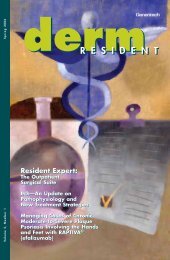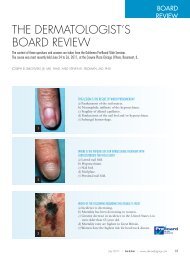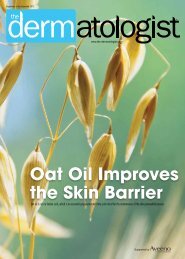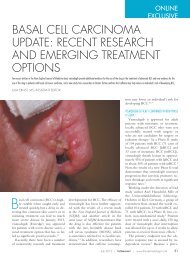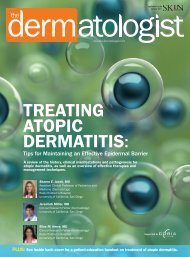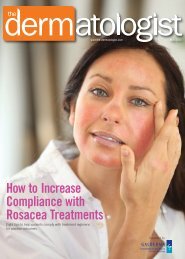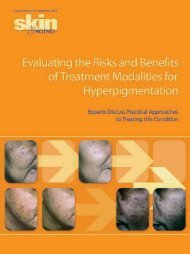Allergic coNtAct DermAtitis of the foot - The Dermatologist
Allergic coNtAct DermAtitis of the foot - The Dermatologist
Allergic coNtAct DermAtitis of the foot - The Dermatologist
- No tags were found...
You also want an ePaper? Increase the reach of your titles
YUMPU automatically turns print PDFs into web optimized ePapers that Google loves.
Allergen FocusTable 2. Differential Diagnosis <strong>of</strong> <strong>Allergic</strong> Contact Dermatitis <strong>of</strong> <strong>the</strong> Foot 18,19Diagnosis Clinical Presentation CommentsACD <strong>of</strong> <strong>the</strong> <strong>foot</strong> (upper/strap) Dorsal <strong>foot</strong> dermatitis sparing <strong>the</strong> interdigital spaces. Classic “shoe pattern dermatitis”ACD <strong>of</strong> <strong>the</strong> <strong>foot</strong> (insole) Plantar dermatitis sparing <strong>the</strong> plantar arch and proximal creases <strong>of</strong> <strong>the</strong> toes. Typically spares areas most involved in palmoplantar pustulosis.ACD <strong>of</strong> <strong>the</strong> <strong>foot</strong> (sole)Can present as plantar dermatitis or as localized plaques <strong>of</strong> dermatitis on <strong>the</strong>thighs/buttock in patients with a habit <strong>of</strong> sitting with <strong>the</strong>ir legs folded and<strong>the</strong>ir feet underneath <strong>the</strong>m.ACD <strong>of</strong> <strong>the</strong> <strong>foot</strong> (stiffeners) Dermatitis involving <strong>the</strong> dorsal toes and heels. Major differential for heel involvement is irritant dermatitis.ACD <strong>of</strong> <strong>the</strong> <strong>foot</strong> (adhesives)Irritant dermatitisMay present with dorsal <strong>foot</strong> dermatitis, plantar dermatitis or heel and toedermatitis.Parched and glazed appearance <strong>of</strong> skin with fine scaling that favors <strong>the</strong> heelsor bridges <strong>the</strong> dorsal toes and <strong>foot</strong> in an “apron pattern.”Heel irritant dermatitis is seen more <strong>of</strong>ten with frequent wearing<strong>of</strong> open back shoes such as flip flops. <strong>The</strong> apron pattern ismore <strong>of</strong>ten seen with atopic dermatitis.Atopic Dermatitis Favors <strong>the</strong> dorsal <strong>foot</strong> in childhood and <strong>the</strong> palmoplantar skin in adulthood. Look for o<strong>the</strong>r atopic stigmata such as Dennie-Morgan lines,allergic shinners, and hyperlinear <strong>the</strong>nar eminences.Nummular DermatitisJuvenile Plantar DermatosisPompholyxDyshidrotic EczemaPsoriasisPalmoplantar pustulosisPityriasis rubra pilarisTinea pedisDiscrete, coin-shaped crusted plaques on <strong>the</strong> dorsal <strong>foot</strong>.Smooth and glazed appearance with fine scaling localized to <strong>the</strong> plantar aspect<strong>of</strong> <strong>the</strong> fore<strong>foot</strong> and toes with sparing <strong>of</strong> <strong>the</strong> interdigital spaces.Severe sudden outbreaks <strong>of</strong> intensely pruritic vesicles symmetrically on <strong>the</strong>palms, soles and lateral aspects <strong>of</strong> <strong>the</strong> digits.Similar to pompholyx but more <strong>of</strong> a subacute to chronic clinical presentationra<strong>the</strong>r than an acute sudden outbreak.Well-demarcated, ery<strong>the</strong>matous plaques with micaceous scale can be seen on<strong>the</strong> dorsal <strong>foot</strong>. Plantar lesions tend to be more hyperkeratotic and <strong>of</strong>ten havea pustular quality. Nail pitting.Bilateral and symmetric ery<strong>the</strong>matous plaques studded with minute pustuleson <strong>the</strong> central palms and soles.Salmon-orange appearing hyperkeratosis <strong>of</strong> <strong>the</strong> plantar <strong>foot</strong> extending up <strong>the</strong>sides in <strong>the</strong> so-called “sandal pattern.” Rarely associated with nail pitting.Dull ery<strong>the</strong>ma and fine scale on <strong>the</strong> sole and sides <strong>of</strong> <strong>the</strong> feet in a “moccasinor sandal pattern.” May see similar fine scaling on one palm giving a “onehand, two feet pattern.”Also known as dermatitis plantaris sicca or “sweaty sockdermatitis.”Keratoderma blenorrhagicum is a plantar eruption characteristic<strong>of</strong> reactive arthritis (Reiter Syndrome).Associated with smoking and thyroid disorders. Likely a localizedacral variant <strong>of</strong> psoriasis.KOH positive for dermatophyte hyphae is diagnostic.T. mentagrophytes can produce a bullous tinea that favors <strong>the</strong>plantar arch.trate <strong>the</strong> textile matrix easily. This createsa reservoir <strong>of</strong> potential allergens indirect contact with <strong>the</strong> skin <strong>of</strong> <strong>the</strong> <strong>foot</strong>for prolonged periods <strong>of</strong> time. <strong>The</strong>normally robust cutaneous barrier <strong>of</strong><strong>the</strong> plantar <strong>foot</strong> may also be diminishedbecause <strong>of</strong> o<strong>the</strong>r conditions like eczemaor dermatophyte infection.Adhesives are necessary in <strong>the</strong> majority<strong>of</strong> <strong>foot</strong>wear for assembly. <strong>The</strong>seglues are used to attach <strong>the</strong> insole to<strong>the</strong> sole and to bind various components<strong>of</strong> <strong>the</strong> shoe top toge<strong>the</strong>r. <strong>The</strong>y area major source <strong>of</strong> shoe allergy. As mentioned,<strong>the</strong> primary relevant shoe adhesivefound on patch testing to cause<strong>foot</strong> dermatitis is <strong>the</strong> phenolic resinPTBFR. PTBFR has been shown toaccount for 10% to 20% <strong>of</strong> allergic reactionsto <strong>foot</strong>wear. 15,16 It has been usedas an additive in rubber glues since <strong>the</strong>1950s and is ideally suited for <strong>foot</strong>wearmanufacturing due to its strong adhesionto both lea<strong>the</strong>r and rubber. 17Heel and toe stiffeners are alsoknown as counters. This component <strong>of</strong><strong>the</strong> shoe is meant to retain <strong>the</strong> overallshape <strong>of</strong> <strong>the</strong> shoe while streng<strong>the</strong>ning<strong>the</strong> heel and toe. Stiffeners have aspectrum <strong>of</strong> complexity, ranging from asimple layer <strong>of</strong> inert adhesive to a complexweb <strong>of</strong> polyester or cotton. Similarto insoles, stiffeners can be a source <strong>of</strong>exposure to rubber compounds, adhesivesand biocides. 16Differential Diagnosis<strong>The</strong> differential diagnosis for an eczematouseruption <strong>of</strong> <strong>the</strong> <strong>foot</strong> can beclinically challenging. A categorical approachis helpful. <strong>The</strong> majority <strong>of</strong> casescan be sorted into one <strong>of</strong> <strong>the</strong> followingprinciple categories: (1) exogenousdermatitis, (2) endogenous dermatitis,(3) acral papulosquamous entities, (4)infectious entities and (5) hybrid dermatitis.18,19 Table 2 highlights this differentialdiagnosis.Exogenous dermatitis includes bothirritant and allergic contact dermatitis.<strong>The</strong> morphology <strong>of</strong> this group is <strong>the</strong>prototypical spectrum <strong>of</strong> acute, subacuteand chronic eczematous eruptions. Itis typical to see a poorly demarcated,spreading, ery<strong>the</strong>matous and edematous,papulovesicular eruption. However, as<strong>the</strong> lesions progress along <strong>the</strong> spectrumto a more chronic state, <strong>the</strong>re is morescaling and lichenification, which cancause some confusion clinically with<strong>the</strong> papulosquamous eruptions. Symptomatologyis useful in that pruritusfavors an allergic etiology and burningand stinging are more <strong>of</strong>ten seen withirritant etiologies. Finally, regional distributionis important to note. <strong>The</strong> clas-22 November 2012 | <strong>The</strong> <strong>Dermatologist</strong> ® | www.<strong>the</strong>-dermatologist.com



